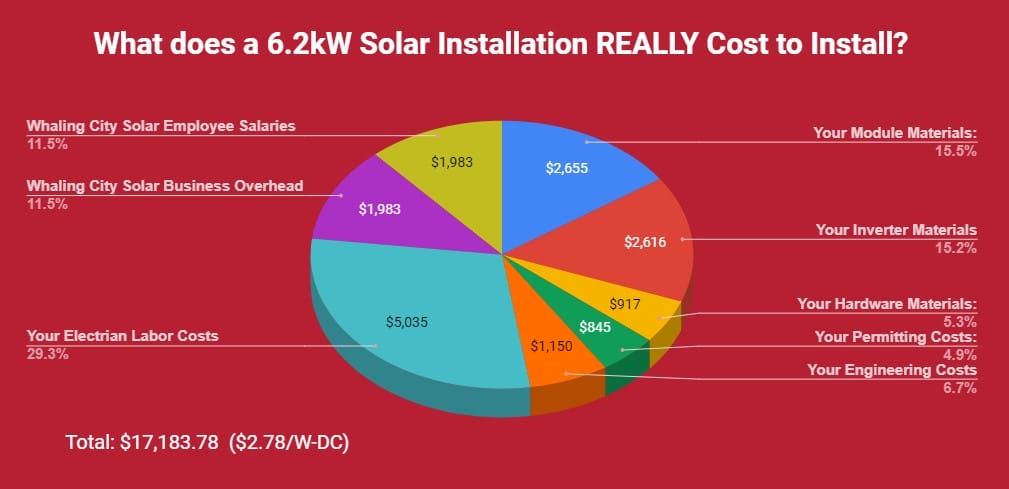The Clean Power Hour – a weekly clean energy headline review and commentary podcast run by Tim Montague, and yours truly – the CommercialSolarGuy – John Fitzgerald Weaver.
First of course, here’s the podcast – Episode 23.
Now, to the news!
SeeThru Solar
First off, CSG Developers LLC – technically the owner of CommercialSolarGuy (and really just a responsible sounding company name) – is starting up a residential solar arm: Whaling City Solar. The sales pitch is that we are testing out a concept called, “SeeThru Solar”. We show you what it costs (below), what we make, and we hope that makes you want to work with us.
Any feedback is appreciated! https://whalingcitysolar.com/
Solar Roadways
I’m sorry, I know the smart and serious people who have *done the spreadsheets* all know that solar panels on the roads just don’t make sense. That’s ok, it might not – but something like it will make sense.
The new system at Peachtree Corners will produce more than 1,300 kilowatt-hours of electricity annually for a Level 2 EV charger at city hall at no cost to EV motorists. The charger is also equipped with an energy storage system for nighttime charging. The Wattway solar roadway panels, manufactured by French transportation innovator Colas Group in partnership with the French National Solar Energy Institute, were engineered to be more durable and efficient – resulting in a 21 percent performance increase over previously deployed panels. Source
Gigawatt scale cantem pv cell output by 2022
“In fact, not only do I believe that multiple gigawatts of tandem will be sold before the end of 2022, I am also confident that in a decade’s time, tandem will command more than 50% of our industry’s market share.” – CEO of 1360 Technologies, author of this article ‘Not happening’…”
History is on my side: The road is littered with the remains of hundreds of solar aspirants, all keen to commercialize some alternative to straight-up crystalline silicon — amorphous silicon, CIGS, CdTe, or GaAs. Not one company, other than First Solar, has been able to succeed commercially in this effort. Time is on my side: Yes, it is. Source
Largest wafer offers lowest LCOE, finds DNV GL
DNV GL’s model shows that both the 182mm and 210mm products do offer lower electricity costs compared to the 166mm product. Based on the site in Spain, the initial investment was 2.9% lower with the 182mm product, and 3.4% lower with Trina’s Vertex module. And this brought down the LCOE by 2.5% and 2.8%, respectively. Results for the site in Texas were similar, with Capex falling 2.8% for the 182mm and 3.6% for the 210, resulting in 3.0% and 3.5% lower LCOE. Source
Aptera Reveals $25,900 (with 250 mile range), and a 1,000-Mile option And Opens Pre-Orders
It claims a range of up to 1,000 miles and achieves that by making the vehicle extremely lightweight, with three wheels and a drag coefficient (Cd) of only 0.13. With that kind of efficiency, it can achieve 250 miles of range on a fairly small battery pack, resulting in a vehicle starting at just $25,900. Buyers can also configure the Aptera with a battery pack that extends the range to 400 miles for $29,800, 600 miles for $34,600, and 1,000 miles for $44,900. Aptera also offers the choice of a 100 kW front-wheel-drive system or 150 kw all-wheel-drive powertrain. Source
Steel Is A Climate Nightmare. Sweden Has A Plan To Make It Green. A pilot plant making steel from green energy and hydrogen instead of coal could have big consequences for an industry with one of the worst environmental footprints.
The HYBRIT plant ― a collaboration between SSAB, Europe’s largest iron ore producer LKAB and power company Vattenfall ― will use renewable energy and hydrogen to extract oxygen from iron ore, producing water as a byproduct, rather than carbon dioxide. The whole process will use no fossil fuels and could mark a monumental shift in an industry which employs 6 million people globally but has struggled to see a place for itself in a decarbonized world. Globally, steel production contributes 7-9% of the world’s direct emissions from fossil fuels, and demand for steel is projected to increase thanks to growing global populations and rising urbanization.
Time lapse of a Veridian Solar residential installation (18 modules at 300 watts each) – Video and images from the installation manual of how the Viridian system protectors your home, while being a beautiful integrated residential solar system. Note how the parts click together. Video is at the top of thread.
That's cool, it's all mechanical (but maybe some spray to get stuff in there the first time) pic.twitter.com/lFLMqa7cn7
— Commercial Solar Guy (@SolarInMASS) December 5, 2020
McKinsey: EU slated for 44 GW annual PV additions in cost-neutral path to net-zero
As electricity demand is set to double due to planned hydrogen electrolyzer capacity, annual PV capacity growth in the EU will leap from the current 15 GW to 44 GW from 2030 onwards. The wind sector will also grow from 10 GW of added annual capacity to 24 GW from 2030 onwards. Source
One last item before we finish: just a beautiful image to end a conversation, we all know this, but to see the number clearly is important:
Hopefully solar power, wind, their needed energy storage, and possible power lines can hold onto that position while it scales up its supply chain.
And last, but not least, the podcast itself – have a great weekend:

